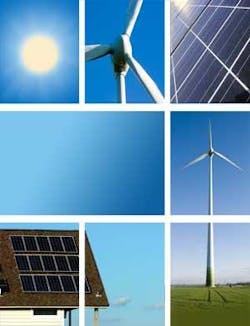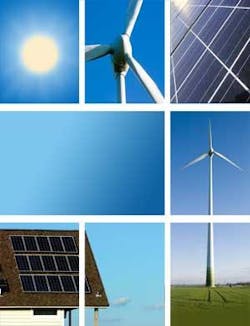ALTERNATIVE ENERGY, PART 2
Financial incentives spur growth of wind and solar
Robust growth is forecast for wind energy and solar power, but improvements in technology, especially for solar, are needed to drive down manufacturing costs.
EDITOR’S NOTE: Alternative energy has been heralded by some as the answer to our dependence on hydrocarbons for transportation fuels and power generation. In this final installment of a two-part series, Don Warlick provides a detailed look at wind energy and solar power.
Accounting for slightly less than 3% of the world’s power generation capacity, wind power is proving to be a successful alternative energy resource. A truly international business, the wind power space is sizable and involves a long chain of manufacturers, investors and the power generation sector itself.
Wind power technology
The technology of wind power is straightforward with proven turbine engineering and appropriate meteorological skills along with power integration and distribution technology. The European turbine manufacturers have been at this for years, so designs and models have improved over time (Fig. 1).
One must start with wind resources, evaluated by wind power density according to a set of seven wind power classes. Class 7, the highest class, calls for local wind speeds of at least 15.7 miles per hour. Class 6 wind speeds range from 14.3 to 15.7 mph and so on. Generally for grid-connected applications, sites for wind farms require a wind power class rating of 4 or higher (at least 12.5 mi. per hour) plus a sustaining wind environment.
Those conditions in the United States will occur in certain states, usually in the Midwest, Southwest, and in the West. Texas is the US leader in wind turbine installations, principally due to significant wind power resources in the western part of the state. The Texas map (Fig. 2) indicates wind speed classes, denoting ideal wind farm locations (orange and red) in five West Texas counties: Presidio, Jeff Davis, Brewster, Hudspeth, and Culberson.
In addition to locating wind turbines on land, Europe is ahead of the world in offshore placement of wind farms. High prevailing winds supply strong wind resources, especially in the North Sea, so countries like Denmark have taken the lead in this area. There are no offshore wind farms in the US to date, but early plans/attempts have been made for the northeast off Massachusetts, in the Gulf of Mexico, and at several other offshore locations.
Applications for turbines for wind power generation will come in three classifications:
- Utility scale –Intended to generate bulk energy for sale in the electric power market. These turbines will range in size from 900 kW to 2 MW;
- Industrial scale –Includes turbines from 50 kW to 250 kW usually needed for onsite or customer use. The power is not for sale to utilities; and
- Residential scale –For micro- and small-size applications no more than 50 kilowatts.
The vast majority of wind energy generated in the US is delivered onto the power grid. Wind power projects can range in size from 20 to 300 MW. A large project could include up to 200 or more turbines at and average size nearing 1.9MW, up from an average of 908 kilowatts in 2001. Usually turbines account for about 75% of total project cost.
Today’s larger turbines can have rotor diameters up to 280 feet. So with a 260-foot hub height, a maximum tip height of almost 400 feet is possible. Due to variability of the wind coursing through wind farms (intermittency) turbines will produce power up to 35% of the time.
But transmission is a significant problem for wind power generation. Larger wind farms are located far from urban concentration. Further, there has been very limited investment in transmission assets by the electric power generation industry in the past 17 years, so new transmission lines will be very important to future wind farm additions.
Wind economics
Regarding economics, there a number of drivers that support wind energy today beginning with the fact that it is a renewable energy source with no carbon emission whatsoever. There’s strong participation of utilities, some of whom are involved with portfolio diversification and entering the business (much like Florida Power and Light).
Favorable prices for wind-generated electric power, ranging from 4¢ to 11¢ per kilowatt hour, are a key reason that wind power accounts for nearly 3% of the world’s electricity production. But it is the tax incentives and other credits made available to the industry that have become very important, as summarized:
RPS – Renewable Portfolios Standards implemented by 21 states and the District of Columbia impose mandatory obligations that cover 40% of the US electricity load. These standards, by state, require the power generation sector to include renewable energy content in their generation portfolios. For example Arizona is asking for 15% renewable content by 2025, California 20% by 2017, Colorado at 10% by 20125farm owners worth $19 per megawatt and available during the first 10 years of operations. In effect, PTCs can reduce the cost of wind power by about one-third.
Today’s new wind farms can be developed by way of several financing vehicles developed by the wind industry for the purpose of investment and taking advantage of federal tax incentives. Two common financing structures employed in 2006 are corporate balance sheet finance and so-called “flip” structures, a favorite of institutional investors.
The typical structure of a new wind project is that of a project partnership involving a sponsor who is most likely the general partner, tax investors who will participate as limited partners, and then a management group to run the project.
There are a number of cash and tax benefits to such a project: The sale of electric power (typically $45 to $65 per megawatt hour), nonregulated sales of RECs, federal tax credit from the PTC, accelerated tax depreciation, plus state incentives. Such a project requires accounting and financial sophistication.
Wind power market
The wind power market for sales of equipment, facilities, and installation services is huge. For wind power, just as the case for most other large-sector businesses, bigger is better. When systems are big utility-scale installations, they can generate electricity at lower costs and compete more directly with coal-fired power. Accordingly the trend to bigger wind farms continues.
The dollar value in 2006 for worldwide wind power installations was $22 billion to $25 billion for plant, equipment, engineering, and installation services. For that same year, new global wind power installations totaled 16,000 MW, more than 40% above 2005, which was in turn, up more than 35% over 2004.
The United States accounted for 15% of new global installations in 2006 at 2,452 MW, slightly higher than 2005. Domestically, Texas and California dominate existing and planned wind power installations as of 30 September 2007 (Fig. 3).
Competitors
Wind power competitors have tended to have a European flair, but now there are more US manufacturers involved in the business. One reason: Shipping the sizable rotor blades can be a logistical nightmare. A selection of wind farm developers and turbine equipment manufacturers:
- Babcock & Brown –Investment and specialized fund/asset management group involved with infrastructure projects, to include renewable energy
- BP –Acquired Greenlight Energy and Orion Energy in 2006, both wind project developers; also invested in Clipper Windpower in 2006, another developer
- FPL Energy –Part of Florida Power & Light, wind project developer
- Gamesa –Spanish manufacturer of turbines, among top five in the world
- GE Wind Energy –Sells largest share of turbines in the US, No. 3 in the world
- Horizon Wind Energy –Developer/constructor of wind farm projects, which it typically owns and operates. Acquired by Energias de Portugal S.A. in mid-2007
- Iberdrola, S. A. –Leading generator and distributor of electricity and natural gas and is also the largest renewable energy operator in the world
- NRG Energy –Wholesale electric power provider with 47 generating facilities in North America, Australia, Europe, and Latin America. Acquired Padoma Wind Power in mid-2006, a wind farm developer in the US and Europe
- Vestas –World’s leading turbine system manufacturer, headquartered in Denmark
Looking ahead, there will be positive growth in global and US markets for wind systems, but not quite as extreme as in the last two years. The tax and financial incentives offered to solar players plus the cost of wind power nearing grid parity are strong support for this growing business.
null
Solar Power
Today solar has a minuscule share of the global power market, accounting for just 0.25% of the world’s total installed electric power. Thermal power generation (oil/gas/coal power) makes up the largest share of global power generation at 68%, hydroelectric is 15%, nuclear 14%, and wind power less than 3%.
But solar is the fastest-growing segment, exceeding 30% CAGR from 1993 to 2006. There is significant room for solar to expand, limited only by materials and capacity constraints, but costs must be significantly reduced, and soon.
Technology
Regarding technology, there are two principal types of solar systems: Photovoltaic (PV) and solar thermal systems. PV is the dominant technology by far in global applications, while thermal systems are a small part with potential. Thermal installations are typically arrayed in reflective mirror fields that concentrate sunlight into a receiver where resulting high temperatures produce steam for electric power generation.
Commercial systems for PV can convert 7% to 17% of sunlight into electric power and will last 20 to 30 years. There are two types of PV systems today:
- Discrete cell technology—which includes monocrystalline and multicrystalline silicon materials sliced from blocks of grown or cast silicon and are the two most-used cell technologies. A third technology, dendritic web, is a process where single-crystal silicon comes from a crucible of molten silicon.
- Integrated thin films—a fast-growing part of PV that can deliver higher efficiency for full-sized power modules. These films are manufactured in sheets/rolls. Thin film is flexible, easy to install, and continues to drive down the cost of installed solar power.
Applications
Solar power from PV has two general applications. The first is off-grid, which can cover a world of applications such as communications, remote power for agriculture or construction, power for highway signs, and small consumer applications with intermittent or remote needs can be satisfied with small power sources.
The second and largest application is for grid-integrated installations for supplementary power used by utility customers presently served by the electric power grid. These applications are for commercial buildings, residences, etc. and will be sizable arrays of installed PV module systems.
Increasingly, building-integrated photovoltaics are being incorporated into commercial buildings and are probably the fastest-growing installation segment in the PV industry. They can be installed on the roof or walls of structures, or even as a part of the roof tile.
There are also solar-based electric power facilities, relatively new and typically sited in the Eastern Hemisphere. Small by comparison to conventionally-fueled power generation facilities (coal, natural gas, oil), these thermal collector and photovoltaic installations are a new approach for special situations. A few examples:
- 154 Megawatt DC peak power heliostat concentrator/photovoltaic technology, currently under construction in Australia
- 62 Megawatt DC peak power plant under construction in Portugal. Contractor/integrators are BP and Yingli Green Energy
- 40 Megawatt DC peak power plant in Germany, a thin-film module construction project with prime contractor First Solar, to be completed in 2009.
Economics of solar
Economics are critical to solar growth, since it is the highest-cost source of electric power today. But efficiencies, technology, and a broadening market are allowing larger cost savings. Approaching grid parity is the endgame here, but there’s a ways to go.
In 1976 the per-watt installed cost for solar was close to $50. Currently it ranges from $6 to $9 per installed watt. The objective is $3 per installed watt, and the industry is working hard to reach this goal. Anticipated timing for achieving grid parity is ∼ 10 years, best case (see Fig. 4).
Important to continuing cost reduction are financial inducements like tax incentives. In the US, the federal government offers a Production Tax Credit, Residential Solar Tax Credit, and Business Energy Tax Credit.
Then there so-called feed-in tariffs where PV-generated electricity is purchased by an electric utility. For example, Germany offers a very generous a feed-in tariff and incentives that have helped to make Germany the largest market for PV installations in the world. The cost issue for solar panels relates primarily to materials (silicon, cadmium telluride, copper materials, etc.), manufacturing capacity, and integration/installation services.
Market segments and competition
End-user PV market segments include residential and commercial/industrial (which is more than twice the size of residential). About 90% of PV installations worldwide are in three countries: Germany, Japan, and the US.
Estimated sales in 2006 for installed PV solar systems worldwide was about 1.7 Gigawatts peak (GWp) and $6 - $11 billion dollars. Growth is anticipated to continue at a high level, at least 25% per year.
With regard to PV competitors, there is a mix of materials providers, manufacturers, constructor/integrators of photovoltaic-based modules and systems worldwide. Some varied examples:
- BP Solar –Manufactures monocrystalline and multicrystalline silicon systems, a participant in solar power since 1973. Installer/integrator for large systems
- GE Energy –Manufacturer/distributor for modules and pre-packaged systems
- Suntech –Growing manufacturer/marketer of solar modules and integrated systems based in China. Planned capacity expansion to reach 1 GW by year-in 2008 (which equates to about half the PV market in 2006)
- Yingli Green Energy –Large vertically-integrated PV manufacturer based in China, sells to integrators, wholesalers worldwide
- First Solar –Largest thin-film solar manufacturer in the world, based in Germany with almost 1 GW of capacity (operating plus announced)
Looking ahead
Solar power growth should continue in robust fashion through at least 2012, limited only by materials availability and manufacturing capacity. Financial and tax incentives should remain in place but continued improvements in technology must drive down manufacturing costs in order to reach grid parity goals by 2018. OGFJ
About the author
Don Warlick [[email protected]] is president of Warlick International, a market and business consultancy established in 1977 that specializes in the global energy business. Previously, Warlick served in marketing and corporate development roles with Getty Oil Co., PepsiCo Inc., and The Williams Companies. He has BS and MS degrees in engineering from The University of Tulsa.







